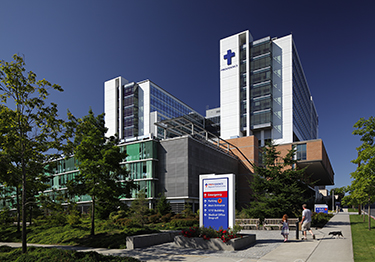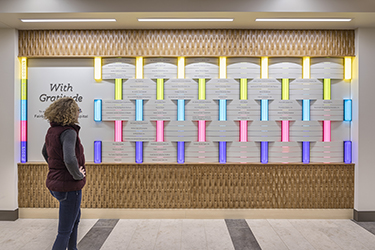|
Subscribe / Renew |
|
|
Contact Us |
|
| ► Subscribe to our Free Weekly Newsletter | |
| home | Welcome, sign in or click here to subscribe. | login |
Construction
| |
 |
February 27, 2020
Good design takes some stress out of visiting the hospital
Knot

Hanks
|
As health care facilities grow in complexity and scale, design firms place an increasing importance on approaching design solutions from the visitor’s perspective.
In the Northwest, where world-class medical facilities play a critical role in the economy and health of our region, it is essential to foster solutions that meet client needs while also addressing the user experience.
At Knot, the emphasis is on early collaboration with design firms to discover design methods that will enhance the experience that patients, families and friends have when visiting facilities such as Providence Regional Medical Center in Everett and the OHSU Center for Health and Healing in Portland.
Knot’s role in these designs includes placemaking, wayfinding and donor recognition solutions.
Wayfinding, or directional signage, at large facilities such as Oregon Health and Science University’s Peter O. Kohler Pavilion, is a critical component to making large-scale health care facilities run smoothly — as thousands of patients, visitors and medical staff navigate this 16-floor building located on Portland’s Marquam Hill each day.
Knot designers place a significant spotlight on putting themselves in the visitors’ shoes. We assume that visitors are coming to facilities such as the Kohler Pavilion or Providence Regional Medical Center for the first time, and the measure of good design should be our ability to make people feel comfortable and connected to these environments.
It’s safe the assume that many visitors to these medical facilities already have a certain amount of stress, so we approach our design solutions with a great amount of delicacy, in terms of the visitor experience.
Making that a reality involved the use of large-scale graphics to provide memorable cues at key entry points at Kohler Pavilion. Our design at Kohler employed panels with greatly magnified nature images printed to film. In the parking garage, Mount Hood, which is visible from Kohler Pavilion, is a key icon represented in parking graphics for each color-coded floor of the underground lot.
A similar bold-colored graphics strategy was part of Knot’s design for the Providence Regional Medical Center in Everett. Knot’s designers created the exterior campus-wide wayfinding program, as well as the interior sign program that gives staff and visitors a coherent yet artfully executed system to navigate the center’s 12-story tower and garage.
Donor recognition
For many medical facilities, such as the Fairbanks Memorial Hospital Surgery Center, a donor recognition wall plays a key role in the overall design. The Fairbanks hospital’s donor wall features color, lighting and forms inspired by the aurora borealis, while highlighting important milestones and people who have been critical to the hospital’s success.
Such donor recognition walls are an important way to recognize a large and diverse group of people who have made contributions and also a gesture by the institution to show its gratitude. Various color schemes and typefaces are part of the design puzzle, and often these elements tie in to our larger wayfinding program for each facility.
At the OHSU Rood Family Pavilion in Portland, Knot designers used the exterior perforated and folded-metal pattern as inspiration for donor signage. The donor recognition program highlights the key role played by donors to the facility such as the Ronald McDonald House Charities of Oregon and Southwest Washington.
For successful programs such as these, design teams need a sensitivity to user experiences. Knot designers have a passion for understanding spatial relationships and creating programs that deliver on the promise of increased efficiency for medical staff and visitors alike. Additionally, advances in new signage materials make this an exciting time to be involved in signage and donor recognition health care projects.
Understanding a client’s needs and close communication with architectural firms early on result in design solutions that are both complex and delicate — all of which make the user feel at ease with every visit.
Marilee Hanks, owner and principal at the Portland landscape architecture/experiential graphic design firm Knot, is passionate about shaping the human experience of place and reinforcing the natural systems that sustain us.
Other Stories:
- Hospital projects in rural areas face extra obstacles
- UW’s new health sciences building will be a hub for 21st-century care
- Building out this new hybrid OR was no simple operation
- Hospitals giving way to other care options as providers look to cut costs
- CHP systems: a powerful energy-saving tool for hospitals
- A look inside the Cure Factory, Seattle Children’s new cell therapy lab
- Fire dampers: one more way hospitals can save lives
- Integrated project delivery offers risks and rewards for team members
- Health care could look a lot different in 2040, so get ready
- Here’s what’s in store for health care in the Northwest
- How welcoming design can improve outcomes for patients — and staff




